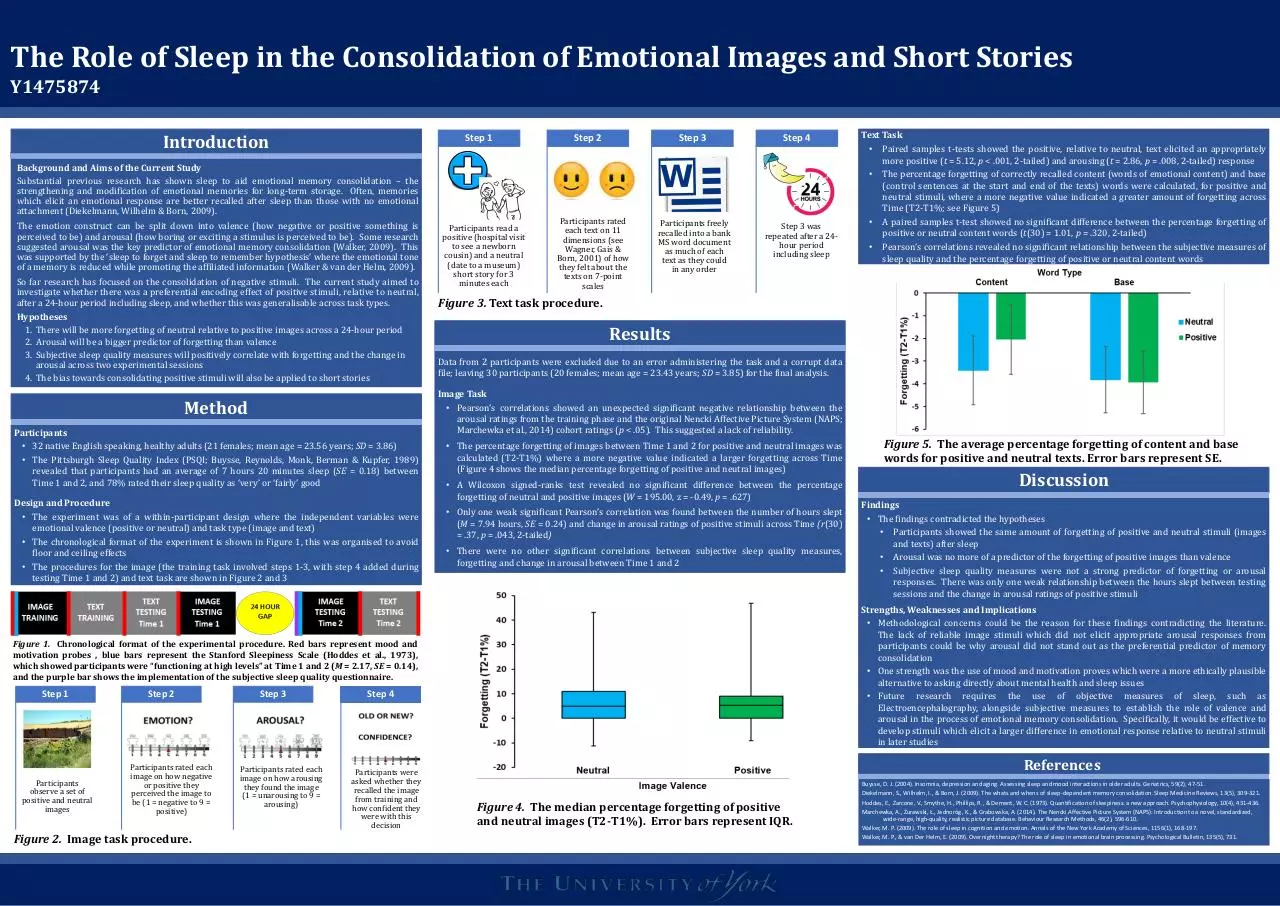Poster2 (PDF)
File information
Title: PowerPoint Presentation
Author: -
This PDF 1.5 document has been generated by Microsoft® PowerPoint® 2016, and has been sent on pdf-archive.com on 08/09/2017 at 00:32, from IP address 2.218.x.x.
The current document download page has been viewed 269 times.
File size: 1.42 MB (1 page).
Privacy: public file

File preview
The Role of Sleep in the Consolidation of Emotional Images and Short Stories
Y1475874
Introduction
Step 1
Background and Aims of the Current Study
Substantial previous research has shown sleep to aid emotional memory consolidation – the
strengthening and modification of emotional memories for long-term storage. Often, memories
which elicit an emotional response are better recalled after sleep than those with no emotional
attachment (Diekelmann, Wilhelm & Born, 2009).
The emotion construct can be split down into valence (how negative or positive something is
perceived to be) and arousal (how boring or exciting a stimulus is perceived to be). Some research
suggested arousal was the key predictor of emotional memory consolidation (Walker, 2009). This
was supported by the ‘sleep to forget and sleep to remember hypothesis’ where the emotional tone
of a memory is reduced while promoting the affiliated information (Walker & van der Helm, 2009).
So far research has focused on the consolidation of negative stimuli. The current study aimed to
investigate whether there was a preferential encoding effect of positive stimuli, relative to neutral,
after a 24-hour period including sleep, and whether this was generalisable across task types.
Hypotheses
1. There will be more forgetting of neutral relative to positive images across a 24-hour period
2. Arousal will be a bigger predictor of forgetting than valence
3. Subjective sleep quality measures will positively correlate with forgetting and the change in
arousal across two experimental sessions
4. The bias towards consolidating positive stimuli will also be applied to short stories
Method
Participants
• 32 native English speaking, healthy adults (21 females; mean age = 23.56 years; SD = 3.86)
• The Pittsburgh Sleep Quality Index (PSQI; Buysse, Reynolds, Monk, Berman & Kupfer, 1989)
revealed that participants had an average of 7 hours 20 minutes sleep (SE = 0.18) between
Time 1 and 2, and 78% rated their sleep quality as ‘very’ or ‘fairly’ good
Design and Procedure
• The experiment was of a within-participant design where the independent variables were
emotional valence (positive or neutral) and task type (image and text)
• The chronological format of the experiment is shown in Figure 1, this was organised to avoid
floor and ceiling effects
• The procedures for the image (the training task involved steps 1-3, with step 4 added during
testing Time 1 and 2) and text task are shown in Figure 2 and 3
Participants read a
positive (hospital visit
to see a newborn
cousin) and a neutral
(date to a museum)
short story for 3
minutes each
Step 2
Step 3
Participants rated
each text on 11
dimensions (see
Wagner, Gais &
Born, 2001) of how
they felt about the
texts on 7-point
scales
Participants freely
recalled into a bank
MS word document
as much of each
text as they could
in any order
Step 4
Step 3 was
repeated after a 24hour period
including sleep
Figure 3. Text task procedure.
Results
Data from 2 participants were excluded due to an error administering the task and a corrupt data
file; leaving 30 participants (20 females; mean age = 23.43 years; SD = 3.85) for the final analysis.
Image Task
• Pearson’s correlations showed an unexpected significant negative relationship between the
arousal ratings from the training phase and the original Nencki Affective Picture System (NAPS;
Marchewka et al., 2014) cohort ratings (p < .05). This suggested a lack of reliability.
• The percentage forgetting of images between Time 1 and 2 for positive and neutral images was
calculated (T2-T1%) where a more negative value indicated a larger forgetting across Time
(Figure 4 shows the median percentage forgetting of positive and neutral images)
• A Wilcoxon signed-ranks test revealed no significant difference between the percentage
forgetting of neutral and positive images (W = 195.00, z = -0.49, p = .627)
• Only one weak significant Pearson’s correlation was found between the number of hours slept
(M = 7.94 hours, SE = 0.24) and change in arousal ratings of positive stimuli across Time (r(30)
= .37, p = .043, 2-tailed)
• There were no other significant correlations between subjective sleep quality measures,
forgetting and change in arousal between Time 1 and 2
Participants
observe a set of
positive and neutral
images
Step 2
Participants rated each
image on how negative
or positive they
perceived the image to
be (1 = negative to 9 =
positive)
Figure 2. Image task procedure.
Step 3
Participants rated each
image on how arousing
they found the image
(1 = unarousing to 9 =
arousing)
Step 4
Participants were
asked whether they
recalled the image
from training and
how confident they
were with this
decision
Figure 5. The average percentage forgetting of content and base
words for positive and neutral texts. Error bars represent SE.
Discussion
Findings
• The findings contradicted the hypotheses
• Participants showed the same amount of forgetting of positive and neutral stimuli (images
and texts) after sleep
• Arousal was no more of a predictor of the forgetting of positive images than valence
• Subjective sleep quality measures were not a strong predictor of forgetting or arousal
responses. There was only one weak relationship between the hours slept between testing
sessions and the change in arousal ratings of positive stimuli
Strengths, Weaknesses and Implications
• Methodological concerns could be the reason for these findings contradicting the literature.
The lack of reliable image stimuli which did not elicit appropriate arousal responses from
participants could be why arousal did not stand out as the preferential predictor of memory
consolidation
• One strength was the use of mood and motivation proves which were a more ethically plausible
alternative to asking directly about mental health and sleep issues
• Future research requires the use of objective measures of sleep, such as
Electroencephalography, alongside subjective measures to establish the role of valence and
arousal in the process of emotional memory consolidation. Specifically, it would be effective to
develop stimuli which elicit a larger difference in emotional response relative to neutral stimuli
in later studies
Figure 1. Chronological format of the experimental procedure. Red bars represent mood and
motivation probes , blue bars represent the Stanford Sleepiness Scale (Hoddes et al., 1973),
which showed participants were “functioning at high levels” at Time 1 and 2 (M = 2.17, SE = 0.14),
and the purple bar shows the implementation of the subjective sleep quality questionnaire.
Step 1
Text Task
• Paired samples t-tests showed the positive, relative to neutral, text elicited an appropriately
more positive (t = 5.12, p < .001, 2-tailed) and arousing (t = 2.86, p = .008, 2-tailed) response
• The percentage forgetting of correctly recalled content (words of emotional content) and base
(control sentences at the start and end of the texts) words were calculated, for positive and
neutral stimuli, where a more negative value indicated a greater amount of forgetting across
Time (T2-T1%; see Figure 5)
• A paired samples t-test showed no significant difference between the percentage forgetting of
positive or neutral content words (t(30) = 1.01, p = .320, 2-tailed)
• Pearson’s correlations revealed no significant relationship between the subjective measures of
sleep quality and the percentage forgetting of positive or neutral content words
References
Figure 4. The median percentage forgetting of positive
and neutral images (T2-T1%). Error bars represent IQR.
Buysse, D. J. (2004). Insomnia, depression and aging. Assessing sleep and mood interactions in older adults. Geriatrics, 59(2), 47-51.
Diekelmann, S., Wilhelm, I., & Born, J. (2009). The whats and whens of sleep-dependent memory consolidation. Sleep Medicine Reviews, 13(5), 309-321.
Hoddes, E., Zarcone, V., Smythe, H., Phillips, R., & Dement, W. C. (1973). Quantification of sleepiness: a new approach. Psychophysiology, 10(4), 431-436.
Marchewka, A., Żurawski, Ł., Jednoróg, K., & Grabowska, A. (2014). The Nencki Affective Picture System (NAPS): Introduction to a novel, standardized,
wide-range, high-quality, realistic picture database. Behaviour Research Methods, 46(2), 596-610.
Walker, M. P. (2009). The role of sleep in cognition and emotion. Annals of the New York Academy of Sciences, 1156(1), 168-197.
Walker, M. P., & van Der Helm, E. (2009). Overnight therapy? The role of sleep in emotional brain processing. Psychological Bulletin, 135(5), 731.
Download Poster2
Poster2.pdf (PDF, 1.42 MB)
Download PDF
Share this file on social networks
Link to this page
Permanent link
Use the permanent link to the download page to share your document on Facebook, Twitter, LinkedIn, or directly with a contact by e-Mail, Messenger, Whatsapp, Line..
Short link
Use the short link to share your document on Twitter or by text message (SMS)
HTML Code
Copy the following HTML code to share your document on a Website or Blog
QR Code to this page

This file has been shared publicly by a user of PDF Archive.
Document ID: 0000669896.